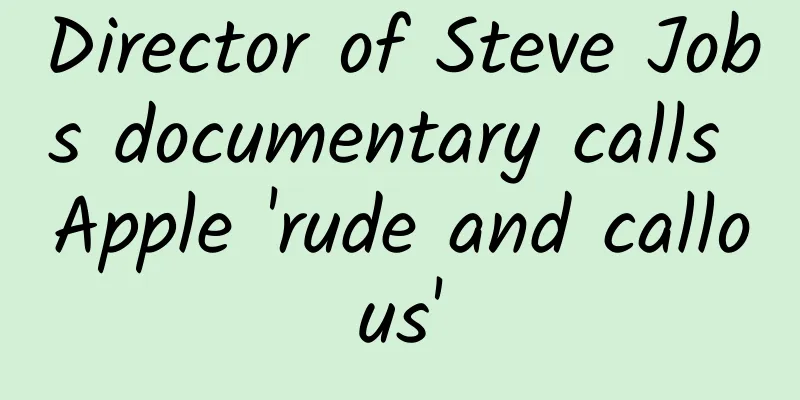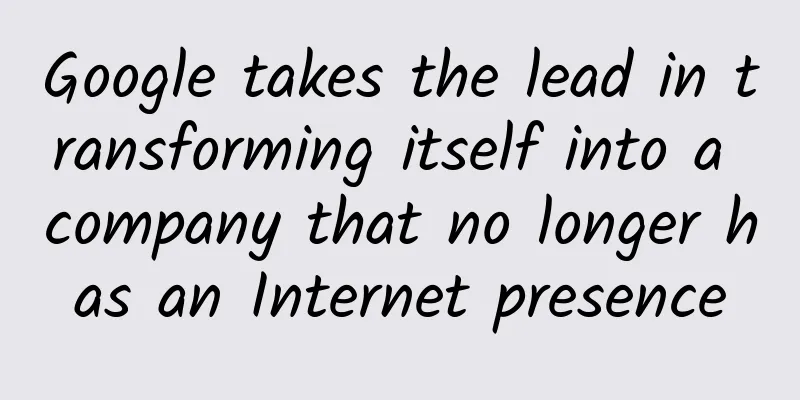Starting from Google, let’s talk about future product design trends

|
The author of this article analyzed many aspects of Google's search products and extracted some trends and directions that may be future product designs. I hope it will be inspiring to you. Since its launch 21 years ago, Google Search has been a success story of great product design. Over the past 20 years, Google has outperformed all of its competitors by focusing on its ambitious goal of "organizing the world's information and making it universally accessible and useful." This isn't just about search; Google and its parent company, Alphabet, have achieved unique success in nearly every category of software. As of May 2019:
By virtue of its excellence and ubiquity, Google has set an unattainable standard for high-quality software products. Search is at the center of everything. Larry Page summarized his vision for search in a 2012 interview with Fortune magazine:
Core PrinciplesFrom day one, Google Search demonstrated how powerful a few simple product design rules can be. 1. Style = Function The defining design choice for Google Search—the one that made it so different from the search landscape of 1998—was about search. In 2019, this seems like the inevitable trend for search engines, but take a look at some of Google’s early competitors when it launched: The difference is clear at a glance. Google’s interface is “transparent”: it’s clear what it does. On the other hand, Google’s early competitors were not transparent. Search was just a sidebar, a supplementary feature, just one of hundreds of elements on the page. There are two reasons for this: Search is still a hard thing to get right If you used the Internet regularly in 1998, you probably remember how long it took to find the right page. Even for a complex query like "corgi OR dachshund NEAR cute dog", finding the right page could take multiple attempts, and most search results had nothing to do with what you were looking for. The most successful Internet companies of the 1990s (such as AOL and Yahoo) planned and aggregated the Internet They provide users with a personalized "start page" that includes links to news, weather, financial markets, and online shopping. The quality of content on the web is often poor and the quantity is low; it is easy for a few site curators to hand-pick the best content the internet has to offer. Google's singular focus on "transparent" search -- "unbundling" it from the aggregation-based approaches of its competitors -- made a big bet on the importance of search. That bet paid off as the Internet grew exponentially in size and standards. All along, google.com was just a search bar: 2. No experience required Over the past few years, the word visibility has started to be used to describe a feature of software products. While there is no clear definition, I think it goes something like this: Visibility: The quality of an interface that enables users to take full advantage of features without instruction. A feature has high visibility if users can quickly learn how to make full use of it. If inexperienced users cannot use or benefit from the feature, the feature has low visibility. Take doorknobs, for example. Some have high visibility: round if they turn, lever-shaped if they push. Some have low visibility: vertical bar doorknobs that look like they can be pushed or pulled, even though the door can only be pushed. (Note: These low-visibility doorknobs belong to Norman Doors, named after Don Norman, who coined the term affordance to describe design elements that hint at how a thing should be used.) Google Search is the gold standard for visibility. That’s because the interface adapts fluidly to individual use cases and experience levels without any settings to configure. Google is so confident that they’ve removed all traces of the Settings page: In 2017, Google got rid of Advanced Search. Why? Because no one was clicking on it. Originally, when you wanted to do a geo search, Google would jump you to Advanced Search. Today, they know you’re doing a geo search and show you a map. To reiterate: Google Search is without a doubt one of the most advanced search engines. Want pictures of cats? Type “pictures of cats”. Want to convert 23.45 parsecs to light years? Type “23.45 parsecs to light years”. The Google Search learning curve is a parallel line. 3. No Errors One of the ultimate principles that Google has always adhered to is that search always works no matter what the user enters. It's resilient. This may seem trivial, but anyone who has built more than one type of input form knows how challenging unpredictable user behavior can be. Google Search does this while processing huge amounts of data: it proudly reports that a search for "dog" yielded approximately 5.48 billion (nearly 5.5 billion) results in 0.89 seconds. Meanwhile, a search for "zzzzzxxxxxxzxxxxxxz" yielded only one result: a signal sent from the Viking orbiter to Earth from Mars on September 14, 1976. The only error a user sees is if their search query is so complex that there are no logical results to show. Even then, it’s true that it’s hard to consider this an error. It just gives the user some suggestions: Adaptive design Google Search's core principles -- design concepts that have been in place since the beginning -- are only part of its success story. More recently, Google Search's design has focused on delivering information before users click on a search result. To do this, Google uses an approach called adaptive design. Adaptive design: The practice of creating user experiences by designing small, independent components, and the rules for how to display those components based on the needs of individual users. Adaptive design means that for every search by every user, a customized interface is produced that molds itself to the information displayed. Take a look at the following examples of how to change the search results page for different use cases: The first way Google Search adapts to user needs is to rearrange the navigation to fit the results. In the case of "lizzo", the navigation below the search box is: (in order) images, videos, news, shopping, more; in the case of "tel aviv", the navigation is: news, images, maps, videos, more; searching for "aapl" (Apple's stock symbol), the navigation shows: finance, news, books, shopping, more; Google has 362,880 unique ways to arrange the navigation to fit the search query. However, the biggest example of adaptive design is the layout of the search results themselves. The results page is completely modular: different elements appear in different configurations depending on the search result. For example, search results for musician Lizzo focus on media: a set of modules displays videos, pictures, and songs in their native formats. Recent news, tweets, and upcoming events are also displayed, along with links to Lizzo's profiles on YouTube, Twitter, Facebook, Instagram, and SoundCloud. It's not until the bottom of the page that we see elements that look like traditional search results. On the other hand, search results for the city of Tel Aviv, Israel, prioritize information for travelers. Images, maps, local weather, and travel-related questions (Is Tel Aviv safe for tourists? What is Tel Aviv famous for?) are prioritized over traditional search results. Modules promote things to do in Tel Aviv as well as recommendations for other nearby cities. Thousands of different modules may appear on the search results page, ranging from simple layout-driven modules to completely independent applications. For example, on the search results page for "aapl", the stock code module displays the current price and an interactive historical price chart. With adaptive design, all decisions about content, format, and order are determined by algorithms. The role of the designer is no longer to create a clear external layout. Today, designers of cutting-edge products, and designers of everyday products in the future, are making decisions about the rules that generate these layouts. Automated testing and iteration The driving force behind the transition from explicit static design to implicit adaptive design is: scale. For the first time since 2000, nearly 4.2 billion people have used the Internet. It stands to reason that most of them are using Google Search. Without advanced testing and automation, it would be impossible for any design team to meet the needs of this large number of users. Google pioneered the use of automated testing in product design. The first A/B test for search took place on February 27, 2000. Although a technical glitch ruined the test, Google doubled down: by 2011, they were running nearly 20 A/B tests per day on their search algorithm. Six years later, that number had increased fivefold; in 2017 alone, Google ran 31,584 tests on its research participants. That’s one new test every 20 minutes for a whole year. These tests resulted in 2,453 changes to the user experience, or about 7 changes per day. These staggering numbers give us a glimpse into the future of product design: as software products grow to reach billions of new users, the opportunity to learn and improve that product is far beyond the capabilities of traditional screen design tools like Sketch, Invision Studio, or Adobe XD. These traditional design tools are geared toward designers who work on relatively simple user experiences with small variations. Feedback on these designs often comes from stakeholders, and using data to enhance designs is a manual process. The speed of design progress is limited by the number of designers on the team. On the other hand, companies like Google are developing entirely new tools that allow researchers to quickly experiment and immediately deploy what they learn. For example, Uber has built a platform that runs more than 1,000 experiments simultaneously. The speed of improvement is no longer limited by the ability of designers to create models and prototypes. To keep up with the scale of the Internet, product designers must become familiar with the language of statistics and machine learning. Product design is less about creating the right experience and more about defining the set of experiments that will yield the best insights. Conclusion The future of product design isn’t for everyone. Doug Bowman, one of Google’s earliest designer hires, publicly decried rapid experimentation when he left the company in 2009: Yes, it is true that the team at Google can’t decide between two shades of blue, so they are testing 41 shades between each blue to see which performs better. I recently had a debate about whether the border should be 3, 4, or 5 pixels, and was asked to prove my case. I can’t work in that environment. I’m tired of arguing about such minor design decisions. There are more exciting design problems in the world to solve. But Google and other industry leaders like Amazon, Netflix, Facebook, and Airbnb have demonstrated the potential of designers who can work in fine-tuned, adaptive environments. After Bowman left, they continued to innovate: Love it or hate it, Google's success is largely due to their commitment to excellent product design. Nowhere is this more evident than in Google Search. |
<<: Apple's 2020 iPhone, see if there is one you like
>>: QQ is really tough! Updated 4 new features to target primary school students
Recommend
Kuaishou APP product analysis report: never just a formality
I can be considered a loyal user of Kuaishou. I c...
Google I/O 2021 Developer Conference: Android 12 New Privacy Features
At the Google I/O 2021 Developer Conference held ...
User retention: How to improve user stickiness?
Do you remember the last time you vowed to stick ...
Genes from bacteria can actually affect courtship?
Recently, researchers from Zhejiang University di...
The new generation of Google Glass actually takes pictures like this
According to a Google patent document, Google Gla...
How to plan and promote an operational activity well?
Without further ado, here are the answers: 1. Cla...
In the era of the short video red ocean, how do companies formulate growth strategies?
Table of contents: Definition of concepts Short v...
King of Glory with 80 million daily active users: How to build a user system
Honor of Kings , a mobile game that is very popul...
Is there any charge for making 400 calls? How are 400 calls charged?
Is there any charge for making 400 calls? How are...
What is the story behind the "cassava vermicelli" mentioned on March 15? How should we choose and eat vermicelli?
At this year's 315 Gala, CCTV exposed an inci...
Will eating too much solid calcium cause kidney stones? The main cause of kidney stones is...
Author: Li Jie, attending physician, Department o...
Too difficult to copy? Why don’t new Android flagships have 3D Touch?
As early as last fall, there were multiple reports...
Technology News | A large amount of water was discovered in the Mariner Valley on Mars
News Station Photo by Wan Shanchao from Xinhua Ne...
10 tips for video marketing promotion!
It is estimated that by 2022, video traffic will ...
Is it not suitable to get married in 2024, the "widow year"? Is the saying that "a year without spring is unlucky" true?
Today, an old folk rumor topped the trending sear...









